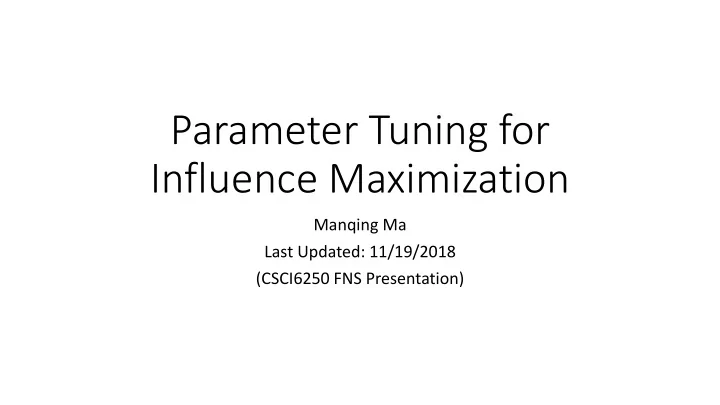

Parameter Tuning for Influence Maximization Manqing Ma Last Updated: 11/19/2018 (CSCI6250 FNS Presentation)
Outline • Objective: Param Tuning for BI /GPI ( ref: Karampourniotis, P. D., Szymanski, B. K., & Korniss, G. (2018). Influence Maximization for Fixed Heterogeneous Thresholds, 1 – 23. Retrieved from http://arxiv.org/abs/1803.02961) • Dataset Preparation • sample graphs and graph metrics • Graph Metrics vs BI parameters: • using machine learning; primary result • Graph Metrics and Hyperparameter Tuning • ideas • Pending work 2
Objective: • Param Tuning for BI Params: a: node resistance (node degree * some distribution within (0, 1)) b: node out-degree (1 st level spread) c: 2 nd level spread (no. of nodes able to be activated in the “neighbors of neighbors”) 3
Objective: • Param Tuning for GPI 4
Param. Tuning in a nutshell params: BI – (a, b), GPI – (v, s) • without information – “ hyperparameter Comparision between grid search and random search, (Bergstra, 2012) optimization” COSTLY • performance: grid search(worse), Bayesian Optimization* random search(better), Bayesian optimization ( sequential model- based optimization (SMBO) )(best) • with information – add graph insight to hyperparameter optimization • graph insight -> more information * https://towardsdatascience.com/a-conceptual-explanation-of-bayesian-model-based-hyperparameter- 5 optimization-for-machine-learning-b8172278050f
Question: • Are the best performance parameters related to certain graph metrics? -- Let’s find out using machine learn ing !
Dataset preparation Use edge swapping Use graph sampling Select/compute method to get to get sample graph metrics on graphs with graphs sampled graphs high/low Sampling methods: ~ 20-30 features assortativity - Edge sampling Ref: Moln´ar, F. Jr, Derzsy, N., - Random Walk sampling Czabarka, E.,´ Sz´ekely, L., Szymanski, B. K. & Korniss G. Dominating Scale-Free Networks Using Generalized Probabilistic - 1080 graph samples Methods. Sci. Rep. 4, 6308 (2014). Source code: By Panos Spearman assort. ~(-0.9, 0.9) 7
Dataset Preparation: (Graph dataset overview) * summarized from 1080 graph samples * Asserted “connected” for every graph in the dataset 8
Dataset Preparation: Graph Metric Overview ( for now )22 selected from metrics used in: Bounova, G., & De Weck, O. (2012). Overview of metrics and their correlation patterns for multiple-metric topology analysis on heterogeneous graph ensembles. Physical Review E - Statistical, Nonlinear, and Soft Matter Physics, 85(1). https://doi.org/10.1103/PhysRevE.85.0161 17 9
Overview (BI) Parameters we need to tune in BI: ● a, for resistence r ○ b, out-degree d ○ Steps: ● 1. A grid search of (a, b)s on a collection of sample graphs and get indicator values: indicator: “ resistance_drop ” & “ coverage ” after 10 rounds of initiator selection 1. Use machine learning to find the best (a*, b*) for given graph metric (m1, m2, ...) 2. Utilize the graph metric information to develop a hyperparameter optimization framework.
Graph Metrics vs BI Params • Basic machine learning models: Random Forest • (primary result) Achieves ~ .8 accuracy on bipartite classification (e.g. best performance a<= 0.5? a > 0.5) • meaningful feature • sigma (node threshold distribution) • degree variance • v ariance of neighbors’ degrees • … 11
Graph Metric and hyperparam. tuning Several Methods -- (1) Pre-train a classification model (e.g. a RandomForest model) using a large quantity of sample graphs. Feed the graph metric values of incoming graph and get the a, b value directly. Monitor the graph change during spreading process if needed. Strength: separate param. tuning and deployment; a. Weakness: b. should need a lot of sample graphs; i. might only achieve good prediction regarding intervals (e.g. [0, 0.2) [0.2, 0.6) ii. [0.6, 1]...)
Graph Metric and hyperparam. tuning Several Methods: (2) Use the graph metric prior information to specify how to search the param. space regarding the dataset in “ hyperparameter tuning ” Strength: could always achieve better a. performance than (1) b. Weakness: might be costly params. have different distributions (regarding best performance param choice)
Graph Metric and hyperparam. tuning General Hyperparam. Optimization Framework: Example: “ Hyperopt ” , Python Input: objective function; search space ; search algorithm (2 implemented so far) import hyperopt as hp #define search space space = hp.uniform('x', -10, 10)
Graph Metric and hyperparam. tuning “ Hyperopt ” Python input: objective function; search space ; search algorithm (2 choices) #other search spaces implementations hp.choice(label, options) hp.randint(label, upper) hp.uniform(label, low, high) hp.quniform(label, low, high, q) hp.loguniform(label, low, high) hp.normal(label, mu, sigma) hp.qnormal(label, mu, sigma, q) hp.lognormal(label, mu, sigma) hp.qlognormal(label, mu, sigma, q)
Graph Metric and hyperparam. tuning “ Hyperopt ” Python input: objective function; search space ; search algorithm (2 choices) ---- The idea is…. To specify the search space with the graph metric information we have.
Graph Metric and hyperparam. tuning Inspect the a, b distribution in our dataset:
Graph Metric and hyperparam. tuning param. distribution could be different given graph metrics: e.g. “ a ” distribution given “ sigma ” ( resistence threshold distribution scale )
Graph Metric and hyperparam. tuning Pending work... 1. How to find the most efficient param. distribution for search space? Define “ efficiency ” - cost and accuracy trade-off a. Derive cost for searching b. How well can we predict the accuracy ahead of searching? c. 2. How to reduce the cost of re-computing graph metrics values in the process of influence spreading? To derive methods for doing it incrementally a. Choose the granularity from experience or current data information b.
> Thank you! 20
Recommend
More recommend